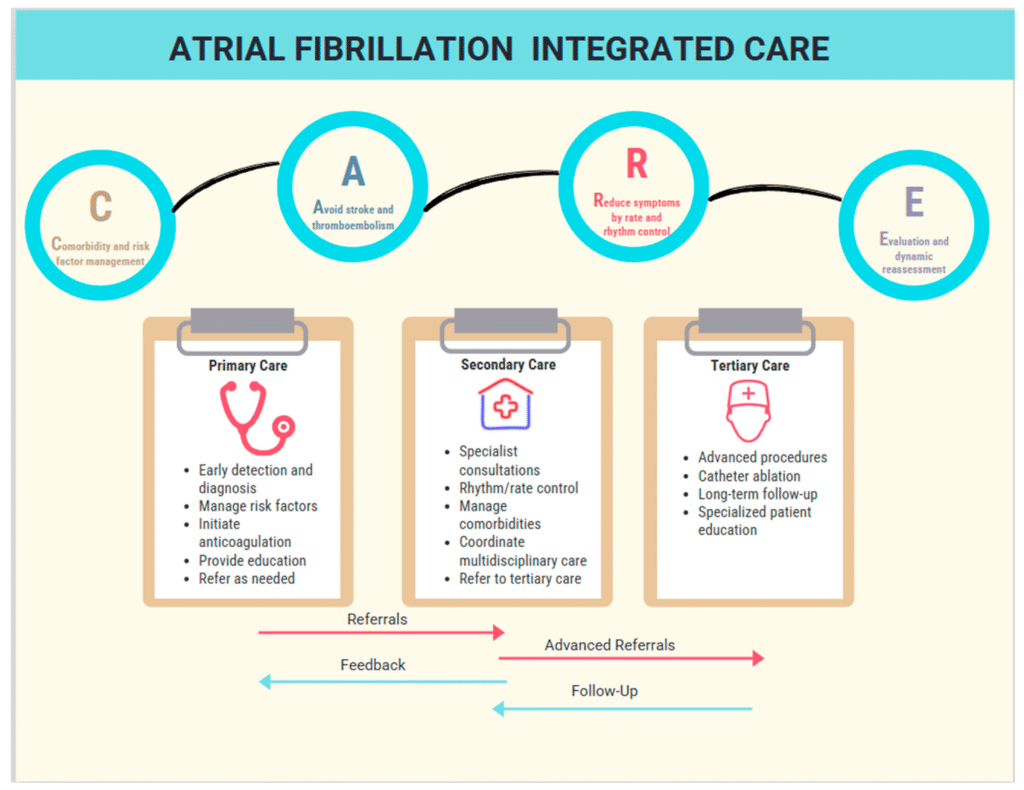Atrial fibrillation (AF or AFib) is one of the most common heart rhythm disorders in the world. It can cause the heart to beat irregularly and often too fast, leading to symptoms like palpitations, shortness of breath, and fatigue. While medications and medical procedures remain essential for many patients, more people are now exploring a holistic approach to atrial fibrillation—an approach that looks beyond just treating symptoms and focuses on improving overall health.
In this step-by-step guide, we’ll break down what a holistic approach means, how it works alongside conventional treatment, and the specific steps you can take to support your heart health naturally.
Step 1: Understanding the Holistic Approach
The term “holistic” means looking at the whole person—not just the disease. In atrial fibrillation, this means addressing lifestyle, nutrition, emotional wellbeing, stress levels, and underlying health conditions along with standard medical care.
A holistic approach to atrial fibrillation doesn’t replace your doctor’s advice—it complements it. The aim is to improve your body’s resilience, reduce AFib triggers, and enhance your quality of life.
Key principles include:
- Focusing on root causes, not just symptoms.
- Supporting heart health through diet, exercise, and stress management.
- Using mind–body therapies to reduce emotional strain.
- Monitoring progress with both medical tests and self-assessment.
Step 2: Diet and Nutrition for AFib
One of the most powerful tools in holistic AFib care is diet. Certain foods and eating habits can reduce inflammation, support heart muscle function, and stabilize your heartbeat.
Heart-healthy diet tips:
- Prioritize whole foods – Fresh vegetables, fruits, whole grains, lean proteins, and healthy fats should form the base of your meals.
- Follow a Mediterranean-style diet – Rich in olive oil, fish, legumes, and nuts, this diet has been linked to improved cardiovascular health.
- Watch your salt intake – Too much sodium can raise blood pressure, putting extra strain on your heart.
- Limit alcohol and caffeine – Both can trigger AFib episodes in sensitive individuals.
- Stay hydrated – Dehydration can worsen heart rhythm irregularities.
Nutrient focus for heart health:
- Magnesium – Helps maintain steady heart rhythm (found in leafy greens, nuts, seeds).
- Potassium – Supports electrical stability in the heart (found in bananas, spinach, sweet potatoes).
- Omega-3 fatty acids – Reduce inflammation and support cardiovascular function (found in salmon, flaxseeds, walnuts).
Step 3: Lifestyle Modifications
Lifestyle plays a huge role in AFib triggers. Making targeted changes can reduce your episodes and improve overall wellbeing.
Lifestyle steps for AFib management:
- Maintain a healthy weight – Excess weight increases strain on the heart.
- Exercise regularly – Moderate activity like walking, swimming, or cycling strengthens the heart and improves circulation.
- Avoid smoking – Tobacco use damages blood vessels and increases AFib risk.
- Get enough sleep – Poor sleep, especially sleep apnea, is linked to irregular heart rhythms.
Tip: If you have sleep apnea, treating it can make a significant difference in AFib control.
Step 4: Managing Stress and Emotional Health
Stress is one of the most overlooked AFib triggers. When stress hormones rise, they can disturb your heart’s electrical system.
Holistic stress-management techniques:
- Mindfulness meditation – Just 10–15 minutes a day can lower stress hormones.
- Yoga and Tai Chi – These combine movement and breathing to calm the nervous system.
- Breathing exercises – Simple slow breathing can restore rhythm and relaxation.
- Counselling or support groups – Emotional support can make AFib easier to manage.
Step 5: Considering Mind–Body and Complementary Therapies
Some people find additional relief through complementary treatments—though these should always be used alongside, not instead of, medical care.
Options include:
- Acupuncture – Some studies suggest it may help reduce AFib recurrence.
- Massage therapy – Promotes relaxation and improves circulation.
- Biofeedback – Teaches you to control body functions like heart rate through awareness.
Always consult your healthcare provider before starting any complementary therapy to ensure it’s safe for your specific condition.
Step 6: Targeting Underlying Health Issues
A holistic approach also means looking for hidden or related health problems that may worsen AFib.
Common underlying contributors:
- High blood pressure
- Thyroid imbalances
- Diabetes
- Sleep disorders
- Chronic inflammation
Treating these conditions can reduce your AFib burden significantly. Your doctor may run tests to identify these issues, and your holistic plan should address them.
Step 7: Supplements and Natural Support
Some people explore supplements to support heart health. While not a replacement for medication, certain supplements may have benefits.
Popular options:
- Omega-3 fatty acids – Anti-inflammatory and heart-supportive.
- Magnesium glycinate – Gentle form that supports electrical heart stability.
- Coenzyme Q10 – Supports energy production in heart cells.
Caution: Not all supplements are safe for people with AFib, especially if you’re taking blood thinners or antiarrhythmic medications. Always get medical clearance before starting any supplement.
Step 8: Monitoring and Adapting Your Plan
Holistic care is not a “one and done” process—it’s an ongoing journey. Keep track of:
- AFib episode frequency and triggers.
- Changes in symptoms.
- Lifestyle habits and diet.
- Stress levels.
Apps, journals, and wearable heart monitors can help you and your healthcare team adjust your plan as needed.
Step 9: Working with an Integrated Care Team
An effective holistic approach to atrial fibrillation often involves collaboration between:
- Cardiologists and electrophysiologists.
- Nutritionists or dietitians.
- Exercise physiologists or physical therapists.
- Mental health professionals.
- Complementary medicine practitioners.
When all members of your care team communicate, you get a more personalized and effective plan.
Step 10: Putting It All Together
Here’s how your holistic AFib plan might look in daily life:
- Morning: 10 minutes of meditation, a breakfast with oatmeal, berries, and flaxseeds.
- Midday: Light walk after lunch; hydrate well.
- Afternoon: Work break with deep-breathing exercises to reduce stress.
- Evening: Mediterranean-style dinner with grilled salmon, quinoa, and vegetables.
- Before bed: Gentle yoga stretches, avoid caffeine after 2 pm, aim for 7–8 hours of sleep.
Final Thoughts
A holistic approach to atrial fibrillation is about much more than “natural remedies”—it’s about creating a balanced lifestyle that supports your heart, reduces triggers, and improves your overall health. By combining medical treatment with nutrition, exercise, stress reduction, and targeted wellness strategies, you can take a more active role in your AFib management.
Remember: Every person’s AFib journey is unique. What works for one person might not work for another. Work closely with your healthcare team to find the right mix of conventional and holistic strategies for you.





